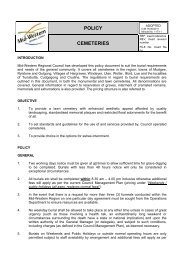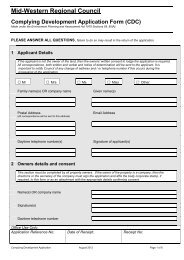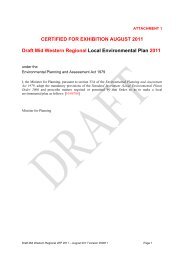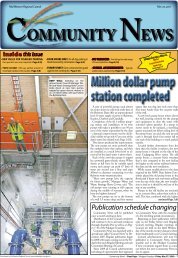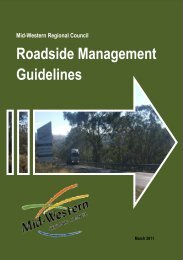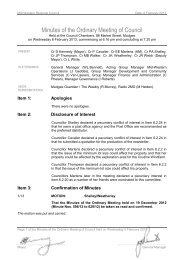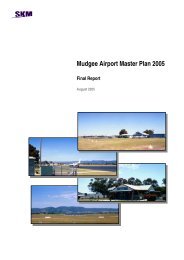preliminary soil salinity assessment - Mid Western Regional Council
preliminary soil salinity assessment - Mid Western Regional Council
preliminary soil salinity assessment - Mid Western Regional Council
You also want an ePaper? Increase the reach of your titles
YUMPU automatically turns print PDFs into web optimized ePapers that Google loves.
Sodium is also often the main cation contributing to saline <strong>soil</strong>s. Sodicity or exchangeablesodium percentage (ESP) is the amount of exchangeable sodium as a percentage of the CEC.ESP = [Exchangeable sodium / CEC] x 100.Soil pH - Measures acidity or alkalinity of a <strong>soil</strong> and is important in determining thecorrosivity of the <strong>soil</strong> to building materials.Chlorides (mg/kg) - These are negatively charged anions which are corrosive to buildingmaterial, such as steels and can damage other building structures. Soluble chloride ions (inwater) gradually penetrate into concrete and cause corrosion of the reinforcement. Sodiumchloride is a type of salt commonly found in saline <strong>soil</strong>s.2.6.3.3 Selected Assessment CriteriaThere is no one prescriptive list of tests to determine the impact of <strong>salinity</strong> prior to development.Soil tests for sodicity are used to provide information on water movement through the <strong>soil</strong> andpossible impediments to drainage. Tests to assist in determining if a <strong>soil</strong> may be corrosive are usedincluding pH, EC and chlorides. Information obtained from the range of tests assists in assessing thepossible impact of water movement through the landscape and interactions with salts through theprofile.Salinity is determined in <strong>soil</strong> tests by measuring the electrical conductivity (EC) of a mixture of 1 part<strong>soil</strong> to 5 parts distilled water (EC 1:5 ). The results can be expressed in µS/cm or converted to dS/m bydividing by 1000.The effects of <strong>salinity</strong> levels expressed as EC 1:5 at 25 o (uS/cm), on plants are:0 to 1,000 very low <strong>salinity</strong>, effects on plants mostly negligible.1,000 to 2,000 low <strong>salinity</strong>, only yields of very sensitive crops are restricted.> 2,000 saline <strong>soil</strong>s, yields of many crops restricted.The impact of EC 1:5 at 25 o is then considered taking into account the inherent electrical conductivityof the <strong>soil</strong> minerals which can be described as the <strong>soil</strong> texture. Relatively impermeable <strong>soil</strong>s such asheavy clays do not allow as rapid flow of electrical current as more permeable <strong>soil</strong>s such as sands. Toallow for such an <strong>assessment</strong>, the EC 1:5 result may then be converted to EC e using a multiplier factorbased on the texture of the <strong>soil</strong> as shown in Table 11: Factors for Converting EC1 :5 to ECe.TABLE 11: FACTORS FOR CONVERTING EC 1:5 TO EC ESoil texture groupMultiplication factorsSands 17Sandy loams 14Loams 10Clay loams 9Light clays 8.5Light medium clays 8Medium clays 7Heavy clays 6Source: ‘Site Investigations for Urban Salinity’, Department of Land and Water Conservation (2002)17PRELIMINARY SOIL SALINITY ASSESSMENT



